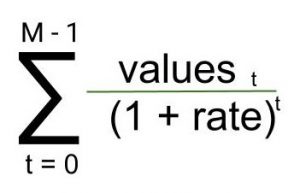numpy.npv() in Python (original) (raw)
Last Updated : 17 May, 2022
numpy.npv(rate, value) : This financial function helps user to calculate the NPV(Net Present Value) of a cash flow series.
Parameters :
rate : [scalar] Rate of discount value : [array_like, shape(M,)] value of cash flows time series. The (fixed) time interval between cash flow “events” must be the same as that for given rate is given. By convention, investments or “deposits” are -ve, income or “withdrawals” are +ve
Return :
present value as per given parameters.
Equation being solved : 
Code 1 : Working
Python `
Python program explaining npv() function
import numpy as np
rate values
a = np.npv(0.281,[-100, 19, 49, 58, 200]) print("Net Present Value(npv) : ", a)
`
Output :
Net Present Value(npv) : 46.5579792365
References : https://docs.scipy.org/doc/numpy-1.13.0/reference/generated/numpy.npv.html .